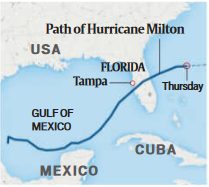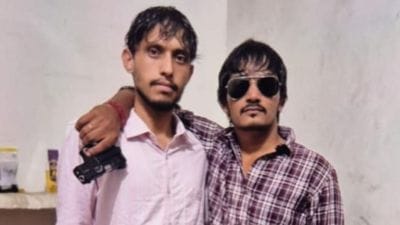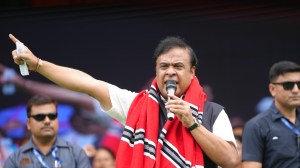
Govt & Politics
Syllabus:
Preliminary Examination: Current events of national and international importance
Story continues below this ad
Main Examination: GS-II: India and its neighbourhood- relations; and Bilateral, regional and global groupings and agreements involving India and/or affecting India’s interests.
What’s the ongoing story– Calling for the restoration of peace and stability in Eurasia and West Asia at the earliest, PM Narendra Modi Friday noted that the most negatively affected countries due to ongoing conflicts in various parts of the world are those from the Global South. Delivering his remarks at the 19th East Asia Summit in Laos on Friday, Modi reiterated that solutions to problems cannot come from the battlefield.
Key Points to Ponder-
— Read about the East Asia Summit, ASEAN, and QUAD
— Which nations constitute the Global South?
— What is India’s East Asia Policy?
— What is the aim and objective of the UNCLOS (United Nations Convention on the Law of the Sea)?
— Map Work: Countries surrounding the South China Sea
For Your Information-
— In a veiled reference to China whose assertiveness in the South China Sea has triggered geopolitical tensions, Modi said, “Our approach should focus on development and not expansionism…”
Story continues below this ad
— “We believe that maritime activities should be conducted in accordance with UNCLOS (United Nations Convention on the Law of the Sea). Ensuring freedom of navigation and airspace is essential…”
— Also mentioning that terrorism poses “a serious challenge to global peace and security”, Modi said that in order “to combat it, forces that believe in humanity must come together and work in tandem”.
— Modi also said India has consistently supported the unity and centrality of ASEAN. “ASEAN is also pivotal to India’s Indo-Pacific vision and Quad cooperation, he said.
Do You Know-
— ASEAN is central to India’s ‘Act East’ policy, which focuses on the extended neighbourhood in the Asia-Pacific region. It was formulated as the next step to the ‘Look East’ Policy which originated in the 1990s.
Story continues below this ad
— In 2010, a Free Trade Agreement was also signed and entered into force between India and ASEAN. While India was part of negotiations to join the Regional Comprehensive Economic Partnership (RCEP) in 2020, it ultimately decided not to do so.
— The East Asia Summit (EAS) process was initiated in 2005 with 16 participating countries, namely the ASEAN Member States, Australia, China, India, Japan, New Zealand, and the Republic of Korea. The United States and the Russian Federation joined later on.
Other Important Articles Covering the same topic:
📍Explained: All about ASEAN and East Asia Summits, to be attended by PM Modi
Previous year UPSC Prelims Question Covering similar theme:
📍Consider the following countries: (2018)
1. Australia
2. Canada
3. China
4. India
5. Japan
6. USA
Which of the above are among the ‘free-trade partners’ of ASEAN?
(a) 1, 2, 4 and 5
(b) 3, 4, 5 and 6
(c) 1, 3, 4 and 5
(d) 2, 3, 4 and 6
Previous year UPSC Mains Question Covering similar theme:
Story continues below this ad
Evaluate the economic and strategic dimensions of India’s Look East Policy in the context of the post Cold War international scenario. (UPSC CSE 2016)
EXPLAINED
Syllabus:
Preliminary Examination: Indian and World Geography – Physical, Social, Economic geography of India and the World.
Mains Examination: GS-I, III: Important Geophysical phenomena such as earthquakes, Tsunami, Volcanic activity, cyclones, etc., and Conservation, environmental pollution and degradation, environmental impact assessment.
Story continues below this ad
What’s the ongoing story– Hurricane Milton, which made landfall near the city of Siesta Key in Florida on Wednesday night, triggered intense rainfall, flooding, tornadoes, storm surge, and strong winds in the area.
Key Points to Ponder-
— What are Hurricanes?
— How are hurricanes formed?
— What is the difference between Hurricanes, cyclones and typhoons?
— How is climate change impacting the frequent occurrence of hurricanes?
— Map Work: Countries surrounding the Atlantic Ocean, Location of the Gulf of Mexico and Straits of Florida.
For Your Information-
— Milton occurred during the peak of the Atlantic hurricane season (mid-August to mid-October). Yet, scientists have said the storm is unusual in many ways — from how quickly the storm intensified to the path it followed — although not surprising.
Story continues below this ad
— Milton exploded from a Category 1 storm (they bring winds of 119 to 153 kmph) to a fierce Category 5 storm (they have winds of 252 kmph or higher) over the course of 12 hours between October 6 and October 7 morning.
— A storm is said to undergo rapid intensification if its maximum sustained winds spike by around 56 kmph, according to a report by The New Yorker. Extreme rapid intensification takes place when wind speeds increase by 93 kmph. Milton’s maximum sustained winds spiked by more than 145 kmph in a day, the report said.
 Path of Hurricane Milton
Path of Hurricane Milton
— It was also rare that Milton formed in the Gulf of Mexico, which is connected to the Atlantic Ocean by the Straits of Florida, then began to move eastward, and made landfall on the Western coast of Florida.
— The most crucial factor behind Milton’s intensification were the remarkably high sea-surface temperatures in the western Gulf of Mexico.
Story continues below this ad
— Heat stored in oceans is a key ingredient in the rapid or extreme rapid intensification of hurricanes. “Put simply, hotter water evaporates more readily, and rising columns of warm, moist air from that evaporation fuel rapid intensification,” according to a Vox report.
— Scientists say that the Gulf of Mexico’s unprecedented temperatures are primarily due to climate change. As the world continues to emit greenhouse gases, more heat is getting trapped in the atmosphere, a significant amount of which is absorbed by oceans.
— Global mean sea surface temperature has gone up by close to 0.9 degree Celsius since 1850, and around 0.6 degree Celsius over the last four decades.
— Another reason for Milton’s severe intensity was the high humidity of the atmosphere. The atmosphere can hold 7% more moisture for every degree-Celsius increase in temperature.
Story continues below this ad
— In recent years, rapid intensification of storms has become more common… Although more research is required to establish the impact of climate change on hurricanes, scientists believe that the spike in rapid intensification is a consequence of rising global temperatures.
Do You Know:
— Climate change is impacting the frequency of heavy downpours during storms and sudden outbursts through its influence on complex atmospheric and weather patterns.
— Globally, at a 1.5C temperature rise, which the world is increasingly close to hitting, heavy precipitation that would have been a once in a 10-year rainfall event will occur 1.5 times every decade and be over 10% wetter, according to the UN’s International Panel on Climate Change (IPCC).
— Last year, Europe was around 7% rainier than normal, with most of the continent experiencing wetter-than-average conditions. Heavy or record-breaking precipitation triggered floods in Italy, Norway, Sweden and Slovenia.
Other Important Articles Covering the same topic:
📍How is climate change impacting flooding around the world?
📍Climate change is causing more frequent, intense cyclones on India’s western coast
Previous year UPSC Mains Question Covering similar theme:
📍Consider the following sentences: (UPSC CSE 2020)
1. Jet streams occur in the Northern Hemisphere only.
2. Only some cyclones develop an eye.
3. The temperature inside the eye of a cyclone is nearly 10°C lesser than that of the surroundings.
Which of the statements given above is/are correct?
(a) 1 only
(b) 2 and 3 only
(c) 2 only
(d) 1 and 3 only
Previous year UPSC Prelims Question Covering similar theme:
📍The Intergovernmental Panel on Climate Change (IPCC) has predicted a global sea level rise of about one meter by AD 2100. What would be its impact in India and the other countries in the Indian Ocean region? (UPSC CSE 2023)
📍‘Climate Change’ is a global problem. How India will be affected by climate change? How Himalayan and coastal states of India will be affected by climate change? (UPSC CSE 2017)
Syllabus:
Preliminary Examination: Current events of national and international importance
Main Examination: GS-II, III: Important International institutions, agencies and fora- their structure, mandate, Science and Technology
What’s the ongoing story– For its “efforts to achieve a world free of nuclear weapons”, the 2024 Nobel Peace Prize was awarded to Japanese organisation Nihon Hidankyo on Friday (October 11). The members of Nihon Hidankyo are survivors of the atom bombings in Hiroshima and Nagasaki by the United States in 1945.
Key Points to Ponder-
— What is nuclear disarmament?
— Why did the USA drop an atomic bomb on Japan?
— What was ‘fat man’ and ‘little boy’?
— What are the global initiatives taken for the disarmament of Nuclear weapons?
— What is India’s stand on nuclear disarmament?
— What is the Non-Proliferation Treaty (NPT)?
For Your Information-
— The Nobel Committee emphasised on Hibakusha’s testimonies which have raised “awareness about the catastrophic humanitarian consequences of using nuclear weapons”, and “contributed greatly to the establishment of the nuclear taboo”.
— Scientists had long theorised that the forces that held together the nucleus of an atom could make up a very destructive bomb. With World War II, research on the subject picked up, not only in the US, which eventually built the first nuclear bomb, but also in the UK, Germany, USSR, and Japan.
— On August 6, the US dropped a bomb named “Little Boy” on Hiroshima. The destruction was unimaginable. Then, on August 9, before the scale of the destruction could even be comprehended, the US dropped “Fat Man” on Nagasaki, killing at least 40,000 people instantly, and tens of thousands more in the days and weeks to come.
— The United States’ decision to drop the bombs has since been criticised from both strategic and ethical perspectives, given its immense human cost. But the bombings forever changed the world, as major powers went on a race to develop their own nuclear weapons as a deterrent to the American one. In response, a global movement for nuclear disarmament emerged.
— Founded on August 10, 1956, Nihon Hidankyo describes itself as “the only nation-wide organisation of A-bomb survivors of Hiroshima and Nagasaki.” Its main objectives are the welfare of the Hibakusha, the elimination of nuclear weapons and due compensation to the victims.
— The work of organisations such as Nihon Hidankyo have helped establish the nuclear taboo, which has ensured that nuclear weapons have not been used since 1945. One of the reasons behind the Nobel Committee’s decision this year is that this taboo is now “under pressure”.
— Not only have new countries sought their own nuclear weapons, improved weapons have been developed as well. Even countries such as the US and Russia, whose active stockpiles are much smaller today than before, have thousands of bombs.
— This year’s recipients are the latest in a list of Nobel awardees who have worked for disarmament. At least 10 Nobel Peace Prizes have been awarded for the cause since 1901.
— This year’s recipients are the latest in a list of Nobel awardees who have worked for disarmament. At least 10 Nobel Peace Prizes have been awarded for the cause since 1901.
— Former Japanese Prime Minister Eisaku Sato was one of the two prize winners in 1974, credited with Japan sticking to its policy of not acquiring nuclear weapons.
— Most recently, the 2017 Nobel Peace Prize was awarded to the International Campaign to Abolish Nuclear Weapons (ICAN).
— Recognition given to the disarmament movement likely stems from the man behind the prize — Alfred Nobel. The Swedish scientist made a fortune with the invention of dynamite and numerous other patents. In his will, he asked that his money be used to award excellence in the sciences, literature and peace.
Do You Know:
— Nihon Hidankyo preserves testimonies and memories of the survivors (called “Hibakusha”) of the only two nuclear weapon attacks in human history at Hiroshima and Nagasaki. In addition, the Japan-based group has been a consistent and vocal advocate for nuclear disarmament and a ban on atomic weapons.
— There is, of course, a context to the Prize. And in the current moment — with at least two devastating wars underway, the suffering of people on screens 24/7 — there are crucial questions to be asked about the moral power of “witnessing” and “remembering” in ending mass violence.
Other Important Articles Covering the same topic:
📍India, Japan discuss developments in areas of disarmament, non-proliferation
📍Express View on Peace Prize: A Nobel lesson in a time of war
Previous year UPSC Mains Question Covering similar theme:
📍With growing energy needs should India keep on expanding its nuclear energy programme? Discuss the facts and fears associated with nuclear energy. (UPSC CSE 2018)
Previous year UPSC Prelims Question Covering similar theme:
📍Consider the following countries: (UPSC CSE 2015)
1. China
2. France
3. India
4. Israel
5. Pakistan
Which among the above are Nuclear Weapons States as recognized by the Treaty on the Non-Proliferation of Nuclear Weapons, commonly known as Nuclear Non-Proliferation Treaty (NPT)?
(a) 1 and 2 only
(b) 1, 3, 4 and 5 only
(c) 2, 4 and 5 only
(d) 1, 2, 3, 4 and 5
Syllabus:
Preliminary Examination: Current events of national and international importance
Main Examination: GS-II: Important International institutions, agencies and fora- their structure, mandate
What’s the ongoing story– India on Friday said it was “concerned” at the “deteriorating” security situation in parts of West Asia after two members of a United Nations peacekeeping mission operating along Lebanon’s border with Israel were injured.
Key Points to Ponder-
— What is the UN Peacekeeping Force?
— Why has the UN kept a peacekeeping force in Lebanon?
— What is the role of the UN Security Council?
— What is the contribution of India to the UN peacekeeping force?
— Map Work: Blue Line
For Your Information-
— The UN has kept the peacekeeping force, known as UNIFIL, in southern Lebanon since 1978. Its mission is largely observational, though its mandate was expanded in 2006 at the end of the last war between Israel and Hezbollah.
— The United Nations Interim Peacekeeping Force in Lebanon is an international body of more than 10,000 civilian and military personnel from 50 countries assigned to prevent violations along the border between Lebanon and Israel. That 121-km stretch is often called the Blue Line.
— The group is charged by the UN with keeping out of the area any weapons or fighters. But over the past decade, the United States and Israel have argued that the peacekeepers have been largely ineffective at preventing Hezbollah from stockpiling and firing rockets from the territory they patrol.
— UNIFIL is supposed to prevent violations in the border zone and report breaches to the UN Security Council.
— During its invasion into southern Lebanon last week, the Israeli military established new positions near one of the UNIFIL bases, according to UN officials.
— A UN spokesperson said the Israeli military had been firing at Hezbollah positions from those locations, putting the peacekeepers increasingly at risk.
— Although attacks on UN personnel violate international law, Hezbollah has for a year launched rockets into northern Israel from close to UN positions in southern Lebanon. That complicates the rules of engagement.
Do You Know-
— The 120-km Blue Line is a UN-recognised demarcation line to indicate that Israel had withdrawn its military from southern Lebanon. It separates Lebanon from Israel and the Golan Heights, but it is not an official international border.
Other Important Articles Covering the same topic:
📍India: Concerned over deteriorating situation in W Asia, monitoring closely
Previous year UPSC Prelims Question Covering similar theme:
📍With reference to the United Nations General Assembly, consider the following statements: (UPSC CSE 2022)
1. The UN General Assembly can grant observer status in the non-member States.
2. Inter-governmental organizations can seek observer status in the UN General Assembly.
3. Permanent Observes in the UN General The assembly can maintain missions at the UN headquarters.
Which of the statements given above are correct?
(a) 1 and 2 only
(b) 2 and 3 only
(c) 1 and 3 only
(d) 1, 2 and 3
EDITORIAL
Syllabus:
Preliminary Examination: Economic and Social Development – Sustainable Development, Poverty, Inclusion, Demographics, Social Sector Initiatives, etc
Main Examination: GS-II, III: Government policies and interventions for development in various sectors and issues arising out of their design and implementation; and Issues related to direct and indirect farm subsidies and minimum support prices; Public Distribution System- objectives, functioning, limitations, revamping; issues of buffer stocks and food security; Technology missions; economics of animal-rearing.
What’s the ongoing story– India’s annual agriculture growth averaged 3.7 per cent during the 10 years that ended 2023-24 under the Narendra Modi government. This was better than the 3.5 per cent during the 10 years of the United Progressive Alliance dispensation, which, in turn, was higher than the 2.9 per cent average of the preceding two decades.
Key Points to Ponder-
— What is the contribution of the livestock and fisheries sector to the GDP?
— What is the Minimum Support Price (MSP)?
— What are the arguments in favour and against the legal MSP?
— What are the challenges for regular field crops in India?
— What necessary reforms need to be taken in the agriculture sector?
For Your Information-
— This growth pick-up, more so in the last decade as per a recent paper by NITI Aayog member Ramesh Chand and Jaspal Singh, belies the general perception of a sector steeped in crisis.
— Much of the seeming farm sector buoyancy of the recent period has come from the livestock and fisheries subsectors. These registered an average year-on-year output growth of 5.8 per cent and 9.1 per cent respectively during 2014-15 to 2022-23.
— However, the crops subsector, which one normally associates with agriculture, grew by just 2.3 per cent, lower than even the 3.4 per cent during the 10 years ended 2013-14 under the UPA.
— Moreover, even within crops, there is a divergence between horticulture and non-horticulture. Horticulture crops production rose at an average annual rate of 3.9 per cent during 2014-15 to 2022-23. The same for non-horticulture or field crops was a meagre 1.6 per cent.
— In sum, the so-called agriculture growth drivers have basically been farming of animals, fish, vegetables and fruit. The “crisis” really is in regular field crops.
— The benefits of minimum support price (MSP) and other government intervention measures are directed mostly to field crops, especially rice and wheat. In contrast, the “support” that milk, poultry meat, eggs, fish and horticulture crops receive is largely from the market. Their growth is demand-led, with Indians increasingly consuming foods rich in proteins, vitamins and minerals.
— Not surprisingly, the states that have posted the highest agricultural growth in recent times — whether Andhra Pradesh and Madhya Pradesh or Maharashtra and Gujarat — are the ones shown to have diversified most into livestock, aqua and horticulture farming.
— The laggards — the likes of Punjab and Haryana — have more or less been cereals- and field crops-focused. The policy lesson here is that farmers are better off when they produce what the market wants and they should be enabled to do so.
— The way forward is to dispense with MSP and crop-specific support. These should be replaced with per-acre transfers assuring farmers of a minimum income that induces them to be more risk-taking and market-oriented. Farmers need access to credit, insurance and technology.
Do You Know-
—- Ramesh Chand writes “The system of Minimum Support Prices (MSP) has remained under pressure since it was started in 1965, especially on issues related to inclusion of crops, the formula or basis of MSP, effective implementation and even its enforcement.”
— “The main reasons for excessive focus on MSP are inefficient and poorly competitive markets, the failure of markets to evolve to meet the changing requirements of the farm sector, neglect of non-price factors to raise productivity and crop income and the direct and instant effect of prices on farm income.”
— “The major issue arising from the new MSP concept is that if demand-side factors do not support the new MSP, the system of marketing will collapse and farmers will suffer. According legal status to MSP, as demanded by some groups of farmers, can also be counterproductive as trade is not bound to buy the entire surplus at legal price if they find it impossible to sell the same produce in the open market with required business margins.”
Other Important Articles Covering the same topic:
📍Has agriculture performed better under Modi govt?
📍How to make MSP work
Previous year UPSC Prelims Question Covering similar theme:
📍Consider the following statements: (UPSC CSE 2023)
1. The Government of India provides Minimum Support Price for niger (Guizotia abyssinica) seeds.
2. Niger is cultivated as a Kharif crop.
3. Some tribal people in India use niger seed oil for cooking.
How many of the above statements are correct?
(a) Only one
(b) Only two
(c) All three
(d) None
THE IDEAS PAGE
Dis/Agree
Syllabus:
Preliminary Examination: Current events of national and international importance
Main Examination: GS-I: Salient features of Indian Society, Diversity of India.
What’s the ongoing story– Food and religion in India are linked. Should vegetarianism be imposed on all citizens because of the taboos and restrictions observed by one community during festivals?
Key Points to Ponder-
— What is the recent controversy around the ban on nonveg food during Navratri?
— What is the Court’s observation on the meat ban?
— How mean ban is connected to Fundamental Rights?
For Your Information-
— Shantanu Gupta writes: Millions of Hindus observe a fast during these nine days, abstaining from tamasic food such as non-vegetarian items, onion, garlic, and specific pulses. To honour the sentiments of those who fast, certain BJP state governments imposed restrictions on the sale of raw meat and non-vegetarian food in areas near temples.
— But, these days, being sensitive to the traditions of the Hindu population evokes arguments about individual choice and curbing freedom.
— For crores of Hindus, food transcends mere nutrition. The Bhagavad Gita delineates three categories of food: Sattvic, rajasic, and tamasic.
— A sattvic diet, characterised by moderation, promotes health and tranquillity, avoiding extremes of flavour. In contrast, rajasic foods, which are rich and stimulating, can lead to hyperactivity and irritability when consumed in excess. All foods produced by harming living beings such as meat and fish are rajasic or tamasic in nature, and are thus discouraged.
— Notably, eight holy cities in India — Rishikesh, Haridwar, Ayodhya, Vrindavan, Pushkar, Mount Abu, Gandhinagar and Palitana — have established year-round bans on non-vegetarian food, reflecting deep-rooted cultural sentiments around food in Hindu communities.
— I strongly feel that if those who eat non-vegetarian food respect the feelings of their Hindu brothers and sisters during the nine days of Navratri, it will only enhance our camaraderie as citizens of this great nation.
Food is personal
— M A Kalam writes: Historically, bans on certain food items, prohibition on the sale of liquor, or censorship of so-called “undesirable” print or electronic material has hardly ever shown constructive, encouraging or positive results.
— It is difficult to fathom how the “safety and convenience of devotees will be prioritised” by the ban on sale of meat and restriction on the availability of liquor. Playing to the gallery, it seems, is not limited just to the realms of sports.
— What one eats and drinks is a personal choice. People in a free and democratic country choose what they would like to, or prefer to, consume or imbibe. There should be no force or compulsion on that count.
— Incidentally, contrary to the widespread belief about the prevalence of vegetarianism, India is predominantly a meat-eating nation — as per NHFS-5 data an overwhelming 83.2 per cent of men and 71.8 per cent of women are non-vegetarians.
— Most butchers and meat sellers in Uttar Pradesh are Muslims, and a large number of those who are engaged in associated activities are Dalits. Measures that affect the ability of minority communities to carry out their economic activities for a certain period are unjust.
— Such bans and restrictions are not even in the arena of moral policing, as there is no universal morality benchmark regarding the consumption of meat and liquor. At best, such standards could exist only within the restricted realm of individual sections or communities in a multicultural society.
Other Important Articles Covering the same topic:
📍We cannot order everybody to be a vegetarian, says Supreme Court
Previous year UPSC Mains Question Covering similar theme:
📍What makes Indian society unique in sustaining its culture? Discuss. (UPSC CSE 2019)
Economy
Goyal: ‘Irrational’ EU standards, unfair rules hurt ties
Syllabus:
Preliminary Examination: Economic and Social Development – Sustainable Development, Poverty, Inclusion, Demographics, Social Sector Initiatives, etc.
Main Examination: GS-III: Indian Economy and issues relating to planning, mobilisation, of resources, growth, development and employment.
What’s the ongoing story– India’s trade minister said on Friday the European Union’s “irrational standards” are hurting business ties and additional tariffs on select imports would force India to retaliate, in his sharpest criticism of the bloc’s policies amid trade pact talks.
Key Points to Ponder-
— Which countries form part of the EU?
— What is Carbon tax?
— What is the Carbon Border Adjustment Mechanism (CBAM)?
— What are India’s concerns regarding CBAM?
For Your Information-
— Goyal also slammed the bloc for “unfair rules” such as a proposed EU carbon border tax known as the carbon border adjustment mechanism (CBAM), adding such measures disrespect and seek to demolish the premise of the 2015 Paris climate agreement.
— The EU last year approved the world’s first plan to impose tariffs on imports of high-carbon goods including steel, cement and aluminium, aiming to reach net-zero greenhouse emissions by 2050. EU officials have been trying to win over countries like China, South Africa and India, that are opposed to CBAM.
— The bloc has also extended safeguard duties on select steel imports, that were set to expire this year, till 2026, impacting Indian shipments.
— In 2022, India and the EU agreed to relaunch talks on a free trade agreement, initially aiming to complete talks by the end of 2023, but have failed to make significant progress on a deal.
Do You Know:
— The Carbon Border Adjustment Mechanism is a plan from the European Union (EU) to tax carbon-intensive products, such as iron and steel, cement, fertiliser, aluminium and electricity generation, from 2026.
— The EU came up with the Carbon Border Adjustment Mechanism in 2021. The European Commission’s website describes it thus, “Designed in compliance with World Trade Organization (WTO) rules and other international obligations of the EU, the CBAM system will work as follows-…
— “EU importers will buy carbon certificates corresponding to the carbon price that would have been paid, had the goods been produced under the EU’s carbon pricing rules. Conversely, once a non-EU producer can show that they have already paid a price for the carbon used in the production of the imported goods in a third country, the corresponding cost can be fully deducted for the EU importer.”
Other Important Articles Covering the same topic:
📍European Union’s carbon tax is arbitrary, a barrier to trade: FM Sitharaman
📍What is carbon border tax, which India opposed at COP27
Previous year UPSC Prelims Question Covering similar theme:
📍With reference to ‘Global Climate Change Alliance’, which of the following statements is/are correct? (UPSC CSE 2017)
1. It is an initiative of the European Union.
2. It provides technical and financial support to targeted developing countries to integrate climate change into their development policies and budgets.
3. It is coordinated by World Resources Institute (WRI) and World Business Council for Sustainable Development (WBCSD).
Select the correct answer using the code given below:
(a) 1 and 2 only
(b) 3 only
(c) 2 and 3 only
(d) 1, 2 and 3
Previous year UPSC Mains Question Covering similar theme:
Should the pursuit of carbon credit and clean development mechanism set up under UNFCCC be maintained even through there has been a massive slide in the value of carbon credit? Discuss with respect to India’s energy needs for economic growth. (UPSC CSE 2014)
Stay updated with the latest UPSC articles by joining our Telegram channel – Indian Express UPSC Hub, and follow us on Instagram and X.



 Path of Hurricane Milton
Path of Hurricane Milton





























